Findings from the study showed that pathologically, 22.4% (13/58) of the patients had viable tumor cells identified in the neck dissection specimen. Seventy-two percent of the patients are currently alive and 28% died as a result of distant disease, local or regional recurrence, or other causes. Of those patients who died from distant disease, 13% had pathological evidence of residual tumor cells identified in the neck dissection specimen. Of the patients who died from local or regional disease, 40% had pathological evidence of residual tumor cells identified in the neck dissection specimen.
Our study demonstrated that performing SND after radiation or chemoradiation did not adversely affect the regional or distant control when compared to historical controls and resulted in similar rates, said Dr. Jacobson. Earlier studies indicate that regional and distant control after a modified radical or radical neck dissection preceded by radiation therapy or chemoradiation approximated 83%8 and 88%,9 respectively.
This study demonstrated pathological evidence of viable tumor in 22.4% (13/58) of the patients after undergoing primary radiation or chemoradiation. We believe that this percentage of persistent viable tumor following treatment supports the need to perform staged SNDs in patients after completion of their adjuvant therapy, said Dr. Jacobson.
SND represents a reasonable surgical alternative to the classic radical and modified radical neck dissections for the management of N2, and possibly N3 disease, after primary medical treatment, continued Dr. Jacobson.
In time, SND may replace the radical and modified radical neck dissection for patients with low-volume (N1, N2) disease and in some cases of higher-volume neck disease that either have a partial or complete response to the chemoradiation, as in our study, said Dr. Jacobson. However, it will not replace the radical and modified radical neck dissections for high-volume disease that has clinically invaded major structures, such as the internal jugular vein, sternocleidomastoid muscle or the accessory nerve.
Preoperative imaging is invaluable in helping to determine whether an effective SND can be performed, continued Dr. Jacobson. One must carefully evaluate the preoperative imaging to make the judgment that a selective neck dissection is the appropriate procedure for any given patient.
Aspiration
During his presentation at the American Head and Neck Society meeting, Dr. Langerman provided results from a study that was done as an adjunct to a larger, prospective, multi-institution clinical trial of induction chemotherapy followed by chemoradiation for advanced head and neck cancer for whom oropharyngeal motility (OPM) study data were available.

Leave a Reply